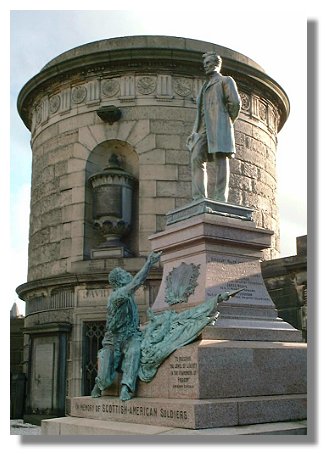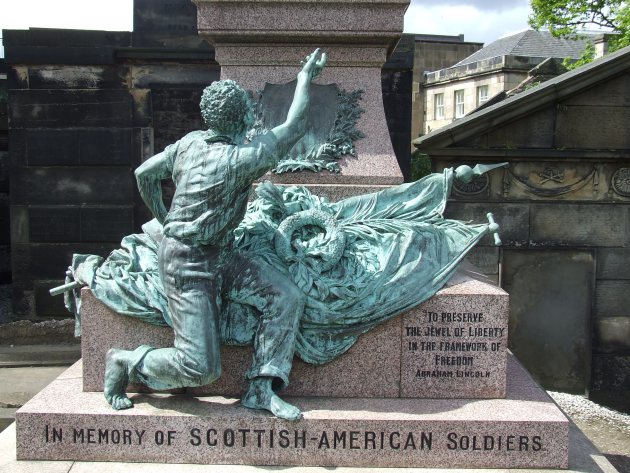| This Week’s Topic… | |

Best viewed in
|
American Civil War Memorial The imposing Edinburgh monument on Calton Hill to the Scots who fought in the Union Army is exceptional as it is the only memorial outside the United States to those who lost their lives in the American Civil War. The monument consists of two statues; a crouching, freed slave extends his arms in gratitude to an imposing Abraham Lincoln. The freed man is resting on furled flags, symbols of victory. The statues are made of bronze and that of Lincoln is about 16 ft high. The base is marble. A medallion on the monument has the flags of Britain and the United States surrounded by thistles and cotton plants.
On the east face of the Edinburgh monument is carved: "In memory of Scottish-American soldiers. To preserve the jewel of liberty in the framework of peace - Abraham Lincoln", and on the west side: "Unveiled 21st August 1893. This plot of ground given by the Lord Provost, Town Council of Edinburgh to Wallace Bruce, US. Consul as a burial place for Scottish soldiers of the American Civil War 1861-5". On the north side the following names are inscribed: "Sgt. Major John McEwan, Co.H, 65th Regt Illinois Vol Infantry; William L Duff, Lt Col., 2nd Illinois Regt of Artillery; Robert Steedman, Co.E, 5th Regt Maine Infantry Volunteers; James Wilkie, Co.C, 1st Michigan Cavalry; Robert Ferguson, Co.F, 57th Regt New York Infantry Volunteers". Dates of birth and death are not given. In fact only two men were buried in the plot and one in an adjacent grave. The
story of the monument is poignant. A Scots woman, Mrs. McEwan, applied
to American Consul Wallace Bruce, for a widow's pension as her husband
had served in the Union Army in the war. Towards the end of
Sergeant-Major McEwan's life his health was so poor and money was so
tight that his wife and children had to go out to work to support their
little family. Things became so desperate that McEwan even tried to give
his precious sword to his doctor in exchange for fees. The doctor said
his business was to save life, not to take it and he wished neither the
sword nor other recompense but pleasant remembrance. Consul Bruce approached the Edinburgh Corporation for a burial site for Scots who had served in the Civil War and had returned to their native land. A plot was provided in the Old Calton Cemetery, close to the tomb of David Hume, the historian and philosopher. Bruce also wished to raise a statue of Abraham Lincoln and launched a fund-raising program in the United States. A well-known American sculptor, George E. Bissell (1839-1920), who had worked in the United States and in Paris, undertook to execute the bronze statue. Bissell was responsible for statues in New York City, including that of Abraham de Peyzaer, an early Dutch settler, which can be seen today in Lower Manhattan. Both Bruce and Bissell had served in the Union Army. The statue was intended to be a gift to Scotland from America, so Bruce obtained subscriptions from many influential Scots-Americans, including Andrew Carnegie. The unveiling ceremony aroused so much interest that admission to the burial ground was by ticket only. Crowds of people stood outside in Waterloo Place, even though the weather was wet and windy. The monument was unveiled on 21 August, 1893 by Bruce's daughter, who was dressed to represent Columbia, wearing a long white dress with a Grecian band of gold in her hair. Bruce gave a long oration but, in view of the weather, postponed reading his 16-verse poem entitled "Columbia's Garland" which he had written for the occasion: Part of Bruce's undelivered poem follows: "Another clasp of loving hands, Another link across the sea, A living word from distant lands To grace the soldiers of the free; Columbia, at her Mother's knee, Unfolds the scroll of Liberty. Through prismed tears let sunlight play, Secure in joy, redeemed in grief, One song unites the Blue and Gray, One glory binds the garnered sheaf War's cruel reaping kindly sealed By brothers of the martyred field" The memorial was rededicated in 1993 on its centenary by Lord Longford. The name of Alexander Smith, G Group, 66th Regt New York Volunteer Infantry, was added on this occasion; his service had been traced, but, as with the other volunteers, little is known about this man. |

